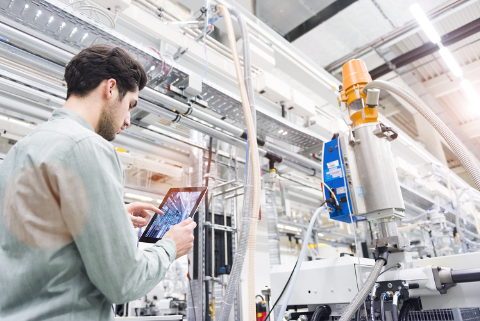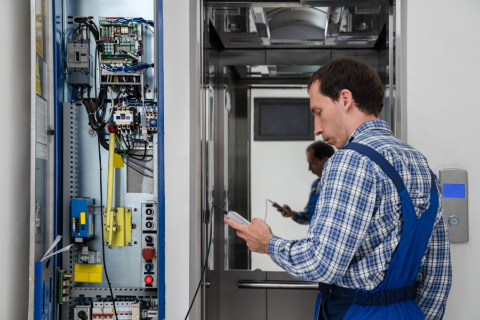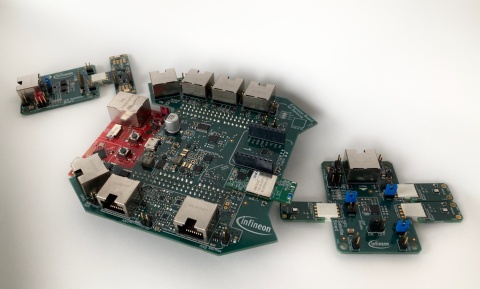
Smart buildings are intelligent – not least because they are able to anticipate maintenance before it becomes urgent. This is known as predictive maintenance. Yet, how is this even possible? What role do Infineon chips play?
How does classic building maintenance work? During periodic maintenance, the employee checks building components and their condition based on the maintenance plan. Parts subject to wear are replaced as necessary, and any signs of wear are documented. In the process the employee also makes a rough check of other components not covered by the plan. The employee's experience and knowledge make it possible to detect potential system failures in buildings, plants and machines at an early stage. But what happens if damage occurs between maintenance intervals?
This is where predictive maintenance comes in. The current and future state of components connected to the predictive maintenance system is assessed by condition monitoring based on status, wear and known additional factors, just as an employee would assess the components. The highlight: Predictive maintenance anticipates eventually required maintenance even beyond planned maintenance intervals. This makes the potential breakdown of a machine predictable and preventable even outside of maintenance intervals.
What is predictive maintenance?

The definition of predictive maintenance refers to being able to anticipate maintenance before it becomes urgent. This building maintenance strategy predicts system failures and aims to prevent them. To make this possible, various parameters are constantly monitored and analyzed. As soon as anomalies in function or wear become apparent, maintenance or repairs can be planned around the regular operation of smart buildings, plants or machines. In addition to improving planning, any upcoming system failures become evident at an early stage and can be prevented – thus making operations more reliable and cost-efficient.
This sophisticated form of condition-based maintenance offers multiple advantages. But how does it differ from other building maintenance strategies? Let's take a look at the definitions of other maintenance strategies to clarify the concept of predictive maintenance.
What other building maintenance strategies are there?

Different maintenance strategies for buildings, plants and machines have developed and evolved over the years. They also serve as the basis for the modern and connected smart maintenance which is essential for Industry 4.0. Generally, all maintenance strategies aim to keep production chains and building systems running economically and with almost no delays. The decision on a maintenance strategy ultimately depends on the given situation.
The classic: breakdown maintenance
One of the most common maintenance strategies is breakdown maintenance – a strategy also employed by private persons. It is also known as reactive maintenance: Repairs do not begin and replacements are not ordered until a part, a machine or system breaks down. This approach is completely based on running something until it fails. Even though planning is impossible, this strategy is still used, and with good reason. Depending on the system it may be more cost-efficient to run parts until they fail. This maintenance strategy is particularly effective in less critical systems and with easily replaceable parts, while more sophisticated strategies such as Preventive Maintenance are implemented in other areas.
Precautionary measures: preventive maintenance
Preventive maintenance enables better planning. This maintenance strategy aims to reduce unexpected failures as much as possible and to introduce more predictability. It is characterized by regular inspection intervals for maintenance, replacements and repairs. Fixed inspection times mean wear is detected earlier. Nevertheless, there is still a residual risk of unplanned system failures.
In predictive monitoring constant monitoring of system performance and state anticipates potential failures outside the planned inspection intervals of preventive maintenance. However, leveraging the potential of predictive monitoring can require what is referred to as condition monitoring.
What is condition monitoring?

Condition monitoring is a prerequisite for predictive maintenance and as such is a component part of predictive maintenance, not a maintenance strategy in itself. Condition monitoring can be compared to an employee who constantly monitors a system’s condition and records any irregularities during operation but does nothing more.
Technology is the key: sensors
Condition monitoring requires sensors. Sensor hardware usually consists of a system of microcontrollers, integrated circuits (ICs) and sensor elements. This combination of components is often collectively referred to as a sensor. Strictly speaking, however, sensors are single micro-electronic components based on semiconductor technology.
Condition monitoring can be employed anywhere from single components of a device to the entire ecosystem of a smart building, providing information on anything from how much toner a printer has to the current use of building lighting. All data collected in a condition monitoring system make deviations from standard values easily recognizable by constantly comparing target and actual values. This provides insight into possible reasons for wear or damage and makes maintenance and repairs easier to plan and more cost-efficient.
How does predictive maintenance work?

The condition monitoring sensors used and the resulting data are the basis for predictive maintenance. Manufacturers like Infineon provide evaluation kits which optimize all the necessary components for sensor systems in a specific application area. Combined with application-specific software, this unlocks a comprehensive data source as the basis for predictive maintenance. For such cases, Infineon offers for example the XENSIV™ Predictive Maintenance Evaluation Kit.
Predictive maintenance devices perform the following tasks, from the moment of measurement all the way to data evaluation:
- Collecting data using sensors
- When appropriate, aggregation of related sensor data:
As soon as more data is to be tracked by the device, such as air quality in relation to air flow, it can be pooled and processed in what is called an IoT sensor node. - Data processing:
Depending on the device, it can be better for the predictive maintenance software to run directly on the device or to hand over the unevaluated data.- Data processing at-the-edge: The data can be processed at-the-edge before being forwarded to a central system such as a cloud platform, or completely autonomous evaluation can take place at-the-edge: The device is “on the edge” of a network. See Edge Computing: Everything you need to know for more information.
- Handover to a central system: Microcontroller technology can hand over the data collected by the sensors to a central building management system or to external cloud services using interfaces such as Wi-Fi or Bluetooth.
- Data evaluation:
Finally, data is evaluated using the appropriate software tools, including an intelligent software algorithm and predictive maintenance AI. These elements can run independently on the edge: One example for this is a single air conditioning system connected to a central system or via a cloud to all the air conditioning systems in a given building. The process then entails two steps:- Software algorithms compare the actual and target status values of the monitored devices, based on sensor data. Any anomalies can be detected, triggering an alarm. Thus the state of the system is recorded and monitored.
- A predictive maintenance AI evaluates relevant data using a model based on machine learning and Big Data. Data sources can be manifold: motors, air flow and composition, vibrations, temperatures, etc. are used to detect any correlation between the values. Thanks to artificial intelligence, a prediction can be made as to if and when a failure can be expected. This makes it possible to predict the future state of a system.
This may sound highly complex at first, but can be illustrated well using the example of a classic maintenance task performed by an employee:
During maintenance, an experienced employee will detect anomalies within a system based on various factors. The employee can detect an air conditioning unit which is running hot just as well as a sensor can; the employee can also check air quality. The employee then draws certain conclusions and makes decisions based on this consolidated information. This includes informing others of the findings so that any surrounding units are checked as well.
How is predictive maintenance relevant to smart buildings?

The sensors are the backbone of the smart infrastructure in smart buildings. After all, smart buildings go beyond digitalization and connectivity. Their connectivity provides consistent comfort and safety and helps optimize building operations. This is where predictive maintenance comes in.
Smart building maintenance can also be incorporated into existing architecture: Here devices with integrated predictive maintenance or which can be connected to larger open systems can be used. This makes smart building maintenance accessible to all companies and building owners. And all buildings have the potential to become smart buildings, provided that the data collected is used effectively.
What does smart building maintenance monitoring look like?

Machine learning is capable of evaluating large amounts of data. The appropriate devices with sensors, connectivity and microcontrollers have to be used to provide the relevant building data for the machine learning element of predictive maintenance. For room and building climates this can be HVAC systems (Heating Ventilation Air Conditioning) that provide data on temperature and functional efficiency. The current building system is expanded to include devices utilizing predictive maintenance technology like new building sensors which detect changes in the quality of incoming and outgoing air or incoming air distribution. Sensors can even track security locking mechanisms and power flow, ensuring greater personal and building security.
Other sensors can monitor the state of refrigeration systems or production machinery. Measurable consumption levels of resources such as power, abnormal running noises and increased vibrations can be tracked with the appropriate predictive maintenance hardware, supporting easy conclusions regarding their functionality. 3D magnet sensors can even track the correct position of machine parts.
Examples of predictive maintenance used in buildings
There is a wide variety of possibilities for using predictive maintenance in buildings. Besides tracking building environment information and assuring equipment safety, working and mechanical equipment within the building can also benefit from predictive maintenance. The predictive maintenance of these elements can be combined to retain a holistic understanding of the entire building ecosystem.
Infineon has developed a Predictive Maintenance Evaluation Kit together with Klika Tech and AWS. This kit makes it possible to monitor several critical elements, for example in a building’s HVAC system. Deviations from normal states can be detected based on a simple anomaly score. The evaluation kit makes it easy to evaluate condition monitoring and predictive maintenance use cases in HVAC systems. Infineon’s sensor and microcontroller technologies are optimally merged with Klika Tech’s experience in the area of IoT and cloud applications. In addition, AWS Cloud Services enable easy scalability within the cloud.
The advantages and disadvantages of predictive maintenance in smart buildings

Predictive maintenance in smart buildings offers advantages ranging from the elimination of unnecessary maintenance tasks to tenant comfort and economic efficiency:
- Cost optimization:
Predictive maintenance technology and devices require an initial investment. When used correctly, predictive maintenance offers an attractive ROI by optimizing maintenance costs: Unexpected failures are avoided and operations continue without disruptions. In addition, maintenance measures are conducted at the right time instead of replacing affected parts too early or too often.
According to the U.S. Department of Energy, predictive maintenance can reduce maintenance costs by up to one third and cut unplanned downtime by up to three quarters.
- Individual service ranges:
Since smart building data and the condition of a building can be analyzed remotely, all maintenance and service tasks can be outsourced together to external providers as a remote monitoring job. Furthermore, the manufacturers of various smart maintenance devices and systems can offer this as an additional service for their devices. The variety of possibilities lets inhabitants and owners of smart buildings focus fully on their own goals. Meanwhile, service jobs are delegated, planned efficiently and coordinated for the entire building without interrupting building operations.
- Employee comfort:
Another advantage of predictive maintenance is the increased comfort and safety for all occupants. The work environment affects employee satisfaction and ability to concentrate. Regular maintenance of HVAC systems provides consistent, good air quality. In turn, this affects employee health and productivity.
Increased safety leads to a decrease in workplace accidents and an increase in employee trust.
Certain prerequisites must be fulfilled within the building or plant to profit from these advantages:
- Correct installation of the devices:
The devices and building infrastructure that will be monitored with predictive maintenance must be correctly installed. Otherwise, the collected data may be incorrect and may lead to incorrect evaluation results, making predictive reliability impossible. The distribution of the devices must also suit the use case: using only a single device to monitor the air quality of each floor offers no true benefit.
- Evaluating relevant data:
Integrating sensors and microcontrollers in new buildings is easy, since an overall concept for the smart building is already possible as early as the building planning phase. On the other hand, in existing buildings, replacing existing technology with predictive maintenance technology requires more effort, since not all devices can be updated at the same time. This makes it necessary to prioritize data relevant to the current building maintenance plan and to understand which data is key to reducing maintenance efforts, in order to update or synchronize the corresponding equipment.
- Further costs:
Although predictive maintenance reduces maintenance and service costs, in addition to the initial investment, predictive maintenance can factor into operational costs, since for example outsourcing data processing may incur new ongoing costs. These may include data storage and processing a central system.
Predictive maintenance solutions for smart buildings

The initial decision to employ predictive maintenance may seem daunting: Many points have to be considered and coordinated with one another. That’s why it is difficult to estimate the potential value of predictive maintenance individually, particularly as the provider of devices with these functionalities.
Offering predictive maintenance solutions calls for a consolidation of expertise in fields such as hardware, software, telecommunications and information technology. Thus Infineon relies on partnerships within the IoT ecosystem to pool this knowledge and provide holistic solutions such as the XENSIV™ Predictive Maintenance Evaluation Kit. Compatibility within the XENSIV™ family means this kit can be used with a wide range of sensors, letting smart buildings see, hear, feel and even understand where action is needed. And this ultimately contributes to smooth building operations.
Get a comprehensive overview of Infineon's Predictive Maintenance product range at: https://www.infineon.com/cms/en/applications/industrial/smart-building/condition-monitoring-and-predictive-maintenance/
Last update: July 2021



